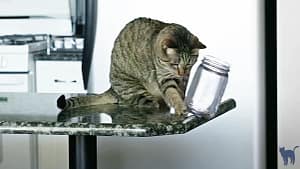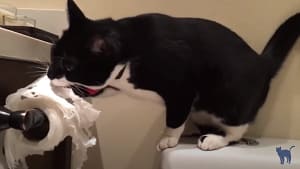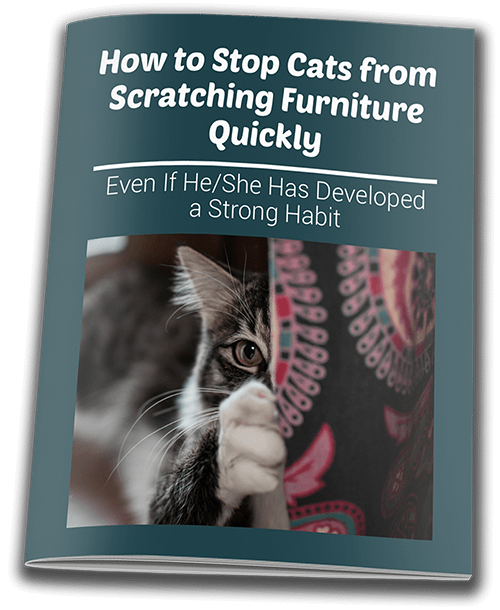The most common domestic cat behavior problems are split into two types. The first refers to normal-species behavior that the caregiver doesn’t like. Among these we can list:
- Destructive scratching,
- Spraying (marking territory),
- Nocturnal overactivity,
- Urge to go outside,
- Eating houseplants, and
- Jumping on things.
Other bad behaviors are a sign of a poor quality environment, emotional trauma, or medical conditions that emerge as bad behavior. These include:
- Pica,
- Anxiety,
- Aggression,
- Excessive meowing,
- Fear of veterinary visits,
- Peeing and/or Pooping outside litterbox.
Domestic cats make excellent companions and are very popular these days. However, many cats show behaviors that their owners find difficult to understand.
Let’s start from the basics. The term “behavioral problem” refers to an animal’s behavior that is unacceptable to his caregiver, regardless of how abnormal it is.
The same behavior can be either a problem or a non-problematic behavior. It all depends on the owner’s perspective.
Sadly, behavioral problems are a common cause of the human-animal bond breaking. This leads to pet relinquishment, abandonment, and, in the worst-case scenario, euthanasia.
Consider this for a moment: as a cat owner, you make all decisions that affect your cat’s living conditions, right?
Then you should pay special attention to their needs. Your cat’s well-being depends on it.
When viewed in this light, it represents a huge responsibility, but it is also great news. Why? Because almost every common cat misbehaves can be managed with a little help from you, even if some of them are real conundrums.
Whether you’re a seasoned cat owner or you’re deciding to adopt one for the first time, I’m so glad you’re here reading this article. Your feline friend will thank you.
In this article, you are going to discover the 12 most common domestic cat behavioral issues and some tips about how to fix them.
Let’s dive into it.
Domestic Cat Behavior Problems (long answer)
Domestic cat behavior issues can be divided into two groups:
Cat normal-species behavior refers to behavior that is typical of the species but is disliked by the caregiver. This type of issue arises, according to experts, because we do not put ourselves in our cat’s shoes. In other words, our lack of knowledge about what the cat’s needs are.
Cat non-normal behavior, consists of bad behaviors that emerge as a result of a poor environment, emotional trauma, or medical conditions.
We’ll go over each one in detail in the following lines.
Cat Normal-Species Behavior
# 1 Destructive Scratching

Cat scratching is one of those behaviors that are natural for the species but is unacceptable by owners. This becomes even more unacceptable if your pet decides to sharpen their nails on your newly expensive couch.
Cats have a strong desire to scratch. The main reason they scratch is to mark territory and leave visual and olfactory cues for other cats. They also scratch to keep their claws sharp and to remove worn-out layers.
Chances are you thought your cat scratched your couch or curtains at times to annoy you. Yet, nothing could be farther from the truth.
Keep in mind that cats do not think in terms of right or wrong. They have no idea of what is good or bad. Their only concern is meeting their own needs.
So, trying to stop cats from scratching is like trying to stop dogs from shaking after they get soaking wet.
However, there is still good news: “Scratching is easy to prevent”. Meaning, you don’t have to endure tattered furniture or prevent your cat from expressing his or her instincts. Above all, there is ABSOLUTELY no need to declaw your cat. It is a cruel and unnecessary procedure.
Often, cats don’t realize what they should and shouldn’t scratch. So you should show them where and what to scratch if you want to channel their behavior.
An excellent approach is to provide him or her with appealing surfaces and objects to scratch like scratching posts.
Here’s a quick rundown of what’s important:
- Offer different surface opportunities (vertical, horizontal, and sloped surfaces);
- Offer different materials as well (cardboard; carpet fabric; or sisal rope);
- Make sure the scratching post is sturdy enough so it won’t fall over when your cat starts scratching on it;
- Choose a tall scratching post. Your cat must be able to stretch her whole body;
- Dab a bit of catnip on the posts to make it more attractive;
- Have more than one scratching post, for example, one on entrances or exits, one near a window and at the highest place possible, and one close where he sleeps.
Training your cat to use a scratching post is a necessary and important step. If you have a cat who scratches where he or she shouldn’t, you’ll find these articles very helpful:
# 2 Marking Territory (Spraying)

Cat spraying is a major headache for many cat owners. Spraying (also called urine marking) happens when a cat sprays a few small drops of urine backward.
Urine is directed at a vertical surface about 8 inches above the ground, such as a wall, a curtain, or a door. Cats perform this action while standing up and raising their tails.
This is something that both males and females can do. Cats will return to the area and remark on it to refresh a fading scent. These chemical marks represent one of the four ways felines communicate.
Cat urine contains pheromones, which are chemical substances that only cats can read. Cats use these substances to communicate with their peers about their age, sex, health, willingness to mate, and the time of the mark.
Why do they do it?
There are two reasons:
- Because of territorial concerns; or
- Because of anxiety and stress.
Conditions that can cause a cat to spray include:
- Problem with a member of the household;
- Moving or remodeling the house;
- Change in the work schedules;
- Another cat visiting the yard;
- New pet or family member;
- Problem with another pet;
- Having visitors.
In most cases, spaying or neutering your cat can stop this devastating behavior. In fact, the problem disappears completely in 90% of sterilized cats.
Another option is reducing the conflict and stress in the environment that triggers the behavior. You can change the cat’s response this way. If you have a problem with another cat in the house, for example, you should keep them apart during the day.
Remember to clean urine-marked areas with an enzymatic cleaner. This will discourage your cat from spraying on the same spot in the future.
You can also try “Live Odor Free”. This product works by canceling out negative ions in odors with positive ions, leaving a neutrally scented space. Avoid using common air fresheners as most times they upset cats since the smell is too strong for their noses.
# 3 Nocturnal Overactivity

Cats are most active at dusk and dawn. So for that reason, they’re known as crepuscular animals. Their circadian rhythm (internal body clock) tells them when it’s time to sleep and when it’s time to wake up.
Its primary function is to signal when it’s time to hunt. Since birds and other cat prey are most active during those hours, their internal body clock is set up to keep them awake.
Unfortunately, these are also the hours when most cat owners are sleeping. So, what can you do if it’s something that they were born with? The simple solution is to match their rhythms to your family’s rhythms.
And if you are wondering “How do I do that?”, wonder no more because here are some tips:
- Establish a fun play session with your cat every night before bedtime to tire him out.
- Enrich his environment so there is plenty to do during the day.
- Mount bird or squirrel feeders near a window out that your cat can see and be entertained;
- Give your cat a food puzzle to play with. It will imitate his natural behavior, keeping him mentally active as he searches for food.
- Items like boxes, bags, and packing paper should be available for your cat to explore.
- Feed your cat with their main meal at night because cats like to sleep after a big meal.
Two more tips:
First, make sure your cat is healthy. Pain could motivate a cat to become more active. So, if you suspect something is wrong, consult your veterinarian. Which leads me to the second tip…
Unless you think they are hurting, don’t pay attention to them. Ignore them completely. Otherwise, you’ll be teaching your cat to keep doing it.
# 4 Urge to Go Outside

Some cats prefer to spend their days indoors and rarely ask to go outside. Likewise, others (many) are resolute about getting a firsthand taste of freedom.
Unfortunately, this causes the cat owner a lot of stress.
When a cat grows up indoors, he doesn’t have the opportunity to learn how to survive outside without his mother. Allowing her to run free puts the cat in grave danger of being hurt or killed. A car, a person who doesn’t like cats, a dog, or even another cat can be all potential threats.
Let’s take a look at why some cats keep asking to go outside. Despite having all their needs met, their instinct still makes them act as they would in the wild. Finding a mate, hunting, and marking their territory is all part of their normal behavior.
Cats are also known for their natural curiosity. So a reason for going outside is because they are bored and want more mental and physical stimulation.
For example, your male cat may have detected a cat in heat or wishes to explore his territory and mark it with his scent. These are all valid reasons for wanting to leave the house.
If you are the kind of owner who wants their cats indoors at all costs, you can try different solutions. You can use interactive toys, puzzle feeders, cat perches, and even cat television to entertain them.
What’s important is letting them act out what their instinct tells them while keeping them entertained. Bear in mind that intact cats attempt to escape far more frequently. As a consequence, we recommend that you spay or neuter your cat.
# 5 Eating Houseplants
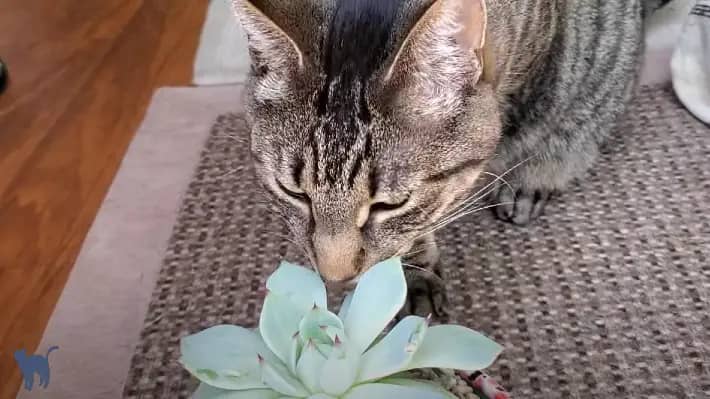
Our feline companions appear to enjoy eating grass and different houseplants. Nearly 70% of cats exhibit this behavior, according to research on this topic.
Plant-eating behavior in domestic cats has long piqued veterinarians’ and cat owners’ interest.
Why do they do it?
Well, research has provided us with an answer.
A recent investigation (2021) gave intriguing results. Leaving aside some of the most commonly accepted theories on the subject:
- Cats suffer from gastrointestinal diseases, and eating grass may make them feel better. The cat’s desire to eat plants is triggered by his discomfort.
- Cats must expel hairballs, and eating plants (particularly grass) aids the digestive tract.
- Cats have a strong desire to vomit, and eating plants helps them do so.
Then, why do cats eat plants if those theories aren’t true?
This study made two important conclusions:
The first is that plant consumption is normal in domestic cats. Researchers proved that wild cats and other felines eat plants in the wild too.
The second and REAL reason cats eat plants is that fibrous plant material aids in parasite expulsion. The grass might have a “scouring effect” in removing worms.
Similar studies in other species, such as chimps, wolves, and other carnivores, have confirmed these outcomes.
In nature, almost all wild carnivores have intestinal parasites to some extent. Regular consumption of plants helps them to keep parasites at a tolerable level.
Indeed, this behavior seems to play an adaptive role even if the animal is not aware of having the parasites inside. Thus, the domestic cat exhibits some of these innate behaviors.
# 6 Jumping on Things
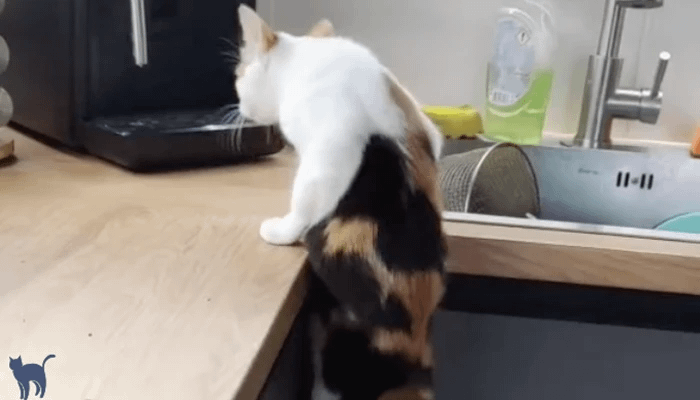
Cats are born with the ability to climb and jump. It’s an instinctual behavior since they climb trees and leap long distances to move through their territory. This is how they avoid danger and find food.
Think of it this way: cats love to hunt small rodents and most ground-based prey are easier to catch from above. Meanwhile, birds are found on trees.
Also, a higher vantage point gives them a better view of their surroundings. It provides an area to hide and take advantage of the warmer air. This lets them have a nap in peace.
Interestingly enough, in a household with many cats, you will see that the dominant one takes the highest place on the perch.
This is why they climb and jump over your furniture, kitchen counters, curtains, walls, fences, and other items.
I know how annoying this feline behavior is, but I have some good news for you: it’s very easy to correct this problem. Remember you can’t teach your cat not to climb, like I said before, it’s an innate behavior. But you can provide them with a more appealing place to jump on.
Almost every cat will want to climb, you should not stop them, but redirect them. There are many types of cat perches and condos you can buy or build by yourself. Both you and your cat will be happier overall.
Cat NON-Normal Behavior
# 7 Pica

Pica is a term that describes a feline’s desire to eat non-edible objects. Plastic, paper, cardboard, cat litter, string, rubber bands, wool, fabrics, electrical cords, and shoelaces are all items they could ingest.
Pica syndrome is more common in kittens and young cats. It could be due to being waned at a young age, according to experts. Dietary deficiencies, boredom, stress, and obsessive-compulsive disorder are all possibilities too.
The typical “Pica behavior” is to grind the object between their back molars several times before ingesting it.
Some studies have found that certain Oriental breeds, such as Siamese, Burmese, and Tonkinese, are more prone to it.
It seems Pica has a genetic component that passes down through specific family lines. Still, it can also affect other domestic cat breeds.
Don’t wait for life-threatening bowel obstruction or underlying medical problems to develop. As soon as you notice your cat’s unusual desire to eat, contact your veterinarian.
# 8 Anxiety
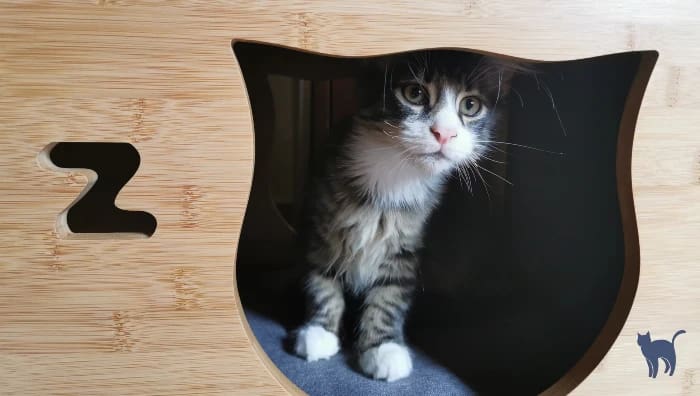
When cats expect danger, they experience anxiety, which then turns into fear. Anxiety and stress are physiological reactions to certain stimuli.
In people, anxiety, stress, and fear can have a very negative effect on health. The same goes for cats, especially if the condition is left untreated.
Anxiety can be caused by factors in your cat’s life that are hard to nail down.
There is a golden rule to follow when it comes to your cat’s well-being. That is, if your cat is acting in a way he hasn’t before, you should take him to the vet. Why? because pain can still produce the same behavior that we’ll describe.
So, you must ensure that your cat is not starting to act out because she is suffering.
Let’s look at some of the signs to see if your cat is stressed or anxious:
Physical manifestation:
- Excessive grooming;
- Diarrhea and vomiting;
- Food avoidance, overeating, or eating too quickly;
- Peeing or pooping outside the litter box;
- Excessive meowing;
- Lethargy;
- Trembling;
- Hypervigilance.
Territorial Manifestation:
- Spraying the house’s perimeter (windows, doors, under doors);
- Hiding;
- Keeping some areas of the house off-limits (where the potential threat could appear);
- Becoming aggressive (suddenly biting owners for no reason);
- Scratching things they shouldn’t or haven’t scratched before.
Relational Manifestation:
- Separation anxiety.
There are many potential causes. Let’s take a look at the most common:
- New pet siblings;
- Bullies among the household cats;
- Moving to a new home or replacing furniture;
- Lack of proper socialization during kittenhood,
- Changes in the daily routine, such as a new job;
- A history of abuse or neglect, a traumatic experience;
- A new family member (like a new baby or a new partner);
- Loud parties and noises, such as national holidays that feature fireworks.
If you can pinpoint the source of your cat’s anxiety, you can take steps to relieve it.
In some cases, removing the stressor, such as ceasing to feed a feral cat, will stop anxiety. In others, you’ll need more perseverance. If your cat has been the victim of cruelty or abuse, it may take longer to fix the issue.
# 9 Aggression
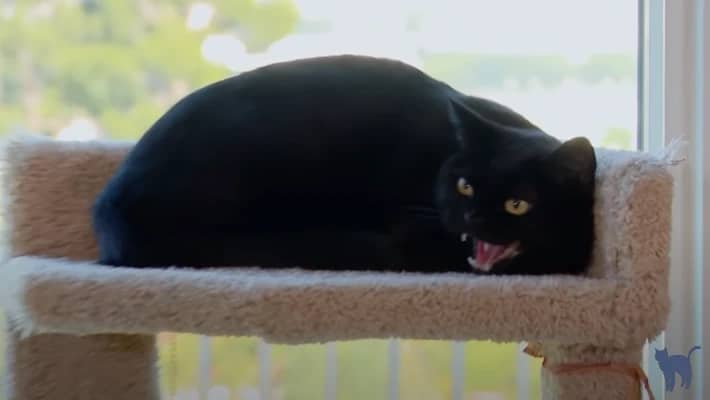
When cats are aggressive with their owner or with other pets present in the house, it endangers their coexistence. So much so that 27% of cats whose owners decide to leave them in shelters are motivated by aggressive behavior.
Stress, anxiety, and medical conditions are the most common reasons for cat aggression. So make sure your cat is healthy. If your cat becomes suddenly aggressive and has never been aggressive before, it could be a sign of pain. When this happens, make sure you visit the vet for a check-up.
Now, let’s see in detail …
What Is Cat Aggression?
Aggression is a broad term that covers a wide range of behaviors. The primary goal is to protect the individual against a real or perceived threat.
This results in hostile or violent behavior directed at a person, another cat, or other animals in an attempt to dominate or intimidate them.
To different degrees, all wild animals exhibit aggression. This is how they protect their territories, defend their offspring, and protect themselves if they are attacked.
The triggering causes of the cat’s aggressive behavior can be many. This is why it’s so difficult (but still feasible) to come up with strategies to stop aggressive feline behavior.
Cat aggression is sometimes taken less seriously than dog aggression. Yet, they have potential weapons (their teeth and claws) that can provoke severe lacerations. So you should not underestimate aggressive cats.
The consequences can be significant, ranging from injuries to other cats, pets, and people. Bite and scratch wounds are painful and can easily become infected.
Although catfights rarely result in fatalities, they can cost cat owners a lot of money in veterinary bills.
Since the stakes are so high, you must figure out what’s causing the cat’s aggressive behavior. This step is critical for making a great intervention plan.
The first thing you should do is keep an eye on your cat for any triggers that may cause him to become aggressive. Like a personality clash between cats. Become a detective and follow the clues. If you are lucky enough to find the “trigger,” you will be able to get rid of it and solve the problem quickly.
But, sometimes, your cat may have to endure the trigger. For instance, when your cat lives with another cat that he doesn’t like. Pheromones, supplements, medications, and special diets can all help if this is the case.
Giving your cat indoor activities to help them avoid boredom and expand their territory is a good idea. So, your cat will have something else to focus and spend his energy on.
To help you search for clues, here is a complete list of the types of aggression cats engage in.
Type of Cat Aggression
- Aggression towards people;
- Aggression between cats in your household;
- Aggression towards dogs;
- Status-related aggression (social dominance);
- Fear aggression;
- Play aggression;
- Redirected aggression;
- Petting-induced aggression (overstimulation);
- Pain-induced aggression;
- Predatory aggression;
- Intact cat aggression:
– Maternal aggression;
– Territorial Agression.
# 10 Excessive Meowing

When it comes to communicating with humans, meows appear to be an all-purpose sound. The first sound a kitten makes is a meow.
Newborn kittens meow to communicate with their mothers that they are cold, hungry, or trying to find the mother’s nipples. However, as they grow older, wild kittens’ youthful vocalization vanishes.
Domesticated cats, instead, maintain it throughout their adult lives. Have you ever wondered why it happens?
The simple answer is because in our family, they never grow up, and they see themselves as our eternal kids.
Meows stay for the rest of their lives only because we pay them attention.
It’s brilliant!
Cats learn that it works, so they keep doing it.
Over time, cats have discovered that meowing is an effective way to get what they want.
But…. When does meowing become too much?
Well, that depends on the listener’s tolerance level. It’s a deeply personal matter. To some extent, every cat will meow. If cats are ignored, they usually stop meowing after a short time. Yet, some cats continue to meow longer than their owners would like. This is likely to cause problems for their families.
Cats that meow constantly are often motivated by behavioral issues. Other factors can also contribute to this upsetting behavior.
First, double-check the obvious:
- Is he hungry or thirsty?
- Is his litter box clean?
- Is the room too hot or too cold?
If this is out of character, consult this list to figure out what’s wrong with your pet:
- Boredom;
- Feeling trapped;
- Stressful situations;
- Attention-seeking;
- Separation anxiety;
- Lack of quality playtime.
If the above list doesn’t work for you, there are still other reasons. If your female cat is unspayed, you should be aware that it is normal for them to vocalize during the mating period. Another factor could be breed. Some breeds, such as the Siamese, are known for their chattiness.
If you’re certain he’s not suffering from any medical issues, we suggest you ignore him. He’ll get used to not getting attention when he meows and will stop.
Remember: Never reward the meowing, instead reward the silence.
# 11 Fear of Veterinarian Visits

Taking your cat to the veterinarian can be a very stressful experience for him. The vet, the car ride, and being locked in the transporter are all terrifying experiences for your pet.
You can, yet, get rid of your cat’s fear with a few simple tricks.
First, select the appropriate carrier, one large enough for your cat to feel comfortable inside it. Then, make him feel safe. You can do this by making the carrier familiar to him. Leave the carrier outside and open it so your cat can use it as a bed and leave his scent. This will allow him to feel cozy when using it for the trip.
Second, introduce your cat into the car slowly. Start by getting the cat inside the carrier, closing it, and putting it into the car. Then, take the carrier out of the car and let your cat out. Repeat this operation until your cat feels calm while you do it.
Third, take small, quick trips. Place your cat in the car and drive him around the block with it. Show him that neither the carrier nor the car is dangerous. Create a joyful association with the experience through positive reinforcement. For instance, rewarding him with a delicious treat after those quick trips.
Another strategy to calm your pet is using use catnip or Feliway products before the visit.
IMPORTANT: Avoid putting gas in your car when you take your cat to the vet. Gases found in service stations are extremely toxic to cats if inhaled. Concentrated gas is so intense it can cause severe discomfort. Worse yet, it creates a negative association with visiting the vet.
Read this article for more information on this subject:
What scents do cats not like (& why you should be aware of them)
# 12 Peeing or Poops Outside Litter Box

10% of domestic cats develop elimination problems, according to ASPAC.
Medical issues are among the most common reasons. Some of them include:
- Bladder stones,
- Urinary tract diseases,
- Crystals in the urine, and
- Inflammatory bowel disease.
These are all possible causes for your cat to start inappropriate elimination. Talk to your vet first to rule these and other health issues out.
Did you know that an adult cat uses the litter box on average 5 times per day? This means there’s a lot of room for mess!
Significant amounts of urine and/or feces are quite often deposited on horizontal surfaces by cats with toileting issues.
Now let’s take into account other potential triggers. Here’s a rundown:
- Surface preference, the cat develops a preference for the surface where it pees, for example, carpet or tile.
- Location preference involves constant elimination in a specific area of the house.
- Box preference, the cat dislikes the size, the shape, or the fact that the box has a hood.
- Litter preference, the cat does not like the type of litter, for example, the texture, the depth, or the smell.
- Anxiety, the cat feels fear because he had been ambushed by another house cat.
- Unpleasant experiences at or near the box, which could be insufficient cleaning, loud noises, or strong odors.
- Difficulty accessing the box.
I understand how upsetting it can be when your pet decides that the litter box is off-limits. But knowing the reasons will help you a lot to fix the situation.
If your cat has formed a preference for a spot, the key factor in shifting these preferences.
You can apply two strategies:
First, making the litter box, litter substrate, or litter box locations more appealing, and
Second, making the surface or location where the cat has changed its toileting habits less appealing (for example, turning the carpet upside down).
Common sense and fantasy allow for a wide range of combinations to these variables. Yet, being consistent usually results in fixing this problematic behavior.
It’s like playing chess with your cat. First, you make a move. Then the cat makes a move. Then you make another move and so on …until… you win!
Conclusion
In this article, we have explored the 12 most common domestic cat behavioral problems. Some of them are more intolerable than others, like aggression, anxiety, spraying, and peeing outside the litter box.
Some others, even if they can create a lot of worries, seem to appear easier to solve. This is the case of scratching furniture, meowing excessively, and nocturnal overactivity. It’s a matter of redirection and knowing your cat well to develop the right strategy.
Instead, other behaviors, if left untreated, could be very dangerous to the cat’s health. That being the case with pica and going outside, both of which could result in death in the worst-case scenario.
Jumping on furniture and eating plants are two issues that cat owners can tolerate to varying degrees depending on their sensitivity.
In my case, for example, I find it intolerable to allow my cat to lay on the kitchen counters (where I prepare my food). Nonetheless, many of my friends let their cats roam on their furniture and even nap at the table.
Now, tell us what you think. Do you have a cat with behavioral issues that I didn’t list? Please share them with us.
The Cat Journey uses only trusted sources, including peer-reviewed studies. This is how we support the tips and information shared in our articles.





